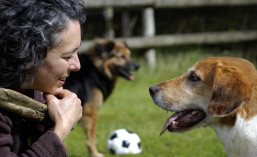Many personal budgets are extra-tight. Since appointments with an animal behaviorist can be pricey, let me share a few suggestions for inexpensive ways you can promote better behavior in your dog.
- Use your dog’s food productively. Every kibble you pour into your dog’s bowl is a lost opportunity. That bit of food could be used instead to reinforce any behavior you like, or to entertain your dog. Follow the lead of zookeepers who face the daily challenge of keeping their clever, energetic animals mentally healthy: they don’t feed “meals” to these animals. Instead, they conduct a brief training session in which food is used as a reward, or, if pressed for time, they stuff the critter’s chow into some sort of hollow toy or durable container.In either case – whether your dog’s food is reinforcement for good behavior throughout the day or a component of a mental enrichment “puzzle,” you’ll be better off than if he had gulped down his daily rations in a few seconds. Consider swapping your dog’s food bowl for two or three of the myriad food-dispensing toys for dogs available in pet stores and online.
- Even if you decide to continue feeding your dog standard meals, never keep a bowl of kibble available to him throughout the day (unless instructed to do so by your veterinarian). This is called “free-feeding” and it ruins most any training program that uses food rewards. Also, it often creates finicky eaters because any resource so commonly available isn’t likely to be highly valued.Offer your dog a healthy meal once or twice a day (more often for young pups), then pick up the bowl after five minutes, whether it’s empty or full. At the next regular meal-time, again offer another normal-sized meal; don’t “make up” for any calories the dog may have missed by snubbing the previous meal.
- Keep your dog out of the behavioral “deep end of the pool.” Imagine what would happen if your dog slipped into your in-ground swimming pool but didn’t know how to swim. He’d panic and flail around, and you’d make every effort to pull him out immediately. Sometime after this dangerous incident, you’d likely get your dog in some very shallow water, to build his confidence and teach him some basic swimming skills. And you’d certainly prevent him from getting near the deep end of that pool again until he’d developed some proficiency at dog-paddling.
Dogs frequently “fall into” environmental situations that they don’t yet have the skills to handle. Common examples include a birthday party at home with a dozen strange guests, a busy dog-park, a chaotic agility trial, or a walk along a noisy crowded street. When overwhelmed by a situation that’s too stimulating or unfamiliar, dogs may become frightened or irritable. This can lead to lunging, growling and, sometimes, biting.As soon as you realize your dog is “drowning” behaviorally, get him out of that environment as calmly and quickly as you can. Then commit to begin training him to cope with a very simplified version of the situation (i.e., get him into a “wading-pool version” of the previous situation) and to keeping him away from such real-life challenges for a while.
- Along these same lines, it’s your job to make sure your dog is behaviorally successful. That means you will get far more training accomplished by setting up the dog’s environment to leave him few options for making mistakes. You’ll then have unlimited opportunities to do your most essential training task: to reinforce any behaviors your dog does that you consider either useful or cute. Positive reinforcement is an amazingly effective behavior-modifier. Animals are hard-wired to repeat any behaviors that “work” for them; that is, any behaviors that turn on food, attention, play, freedom, toys, etc. By providing frequent, well-timed and meaningful reinforcement to our dogs, we can lock in desired behaviors such as coming when called, settling on a mat, or walking calmly by our side while on-leash.
Training that consists of repeated naggings and scoldings for misbehaviors is inefficient and no fun for anyone. Have you ever had a job in which your boss gave you difficult assignments without much guidance and constantly criticized your efforts? You likely ended up hating that job, and often your boss too. And your work didn’t reveal your full potential.
Avoid having to punish your dog – and having him rehearse unwanted behaviors like stealing food off the counter, jumping on guests or urinating in the house – by controlling his access to environments beyond his current level of training.
- Know that dogs really shouldn’t approach and “say hi” to unfamiliar dogs when walking on leash. This is not what behaviorists and trainers mean when we advise people to socialize their dogs to a variety of other dogs. Choreographing the initial greeting of two leashed dogs who’ve never met is an advanced skill for owners and it’s not one you need to master. It’s quite common for owners to create tense situations by tightening their dog’s leash or by allowing one dog to rush up to another. This can easily lead to an unpleasant experience for one or both dogs, or worse, a dogfight.
Dogs meeting and greeting each other do best when allowed to use their highly-nuanced body language to communicate their intentions. Being on a leash generally interferes with this natural tension-diffusion system.So train your dog to walk past unfamiliar dogs you see in public, just like you walk past all the strangers you see. And do set up frequent play-dates for your dog to socialize off-leash in an enclosed area with a few doggie friends.
Of course, you may still have concerns about your dog’s behavior even if you follow this advice. That’s why applied animal behaviorists and trainers are in business. But these guidelines may help you save some money — and misfortune.
